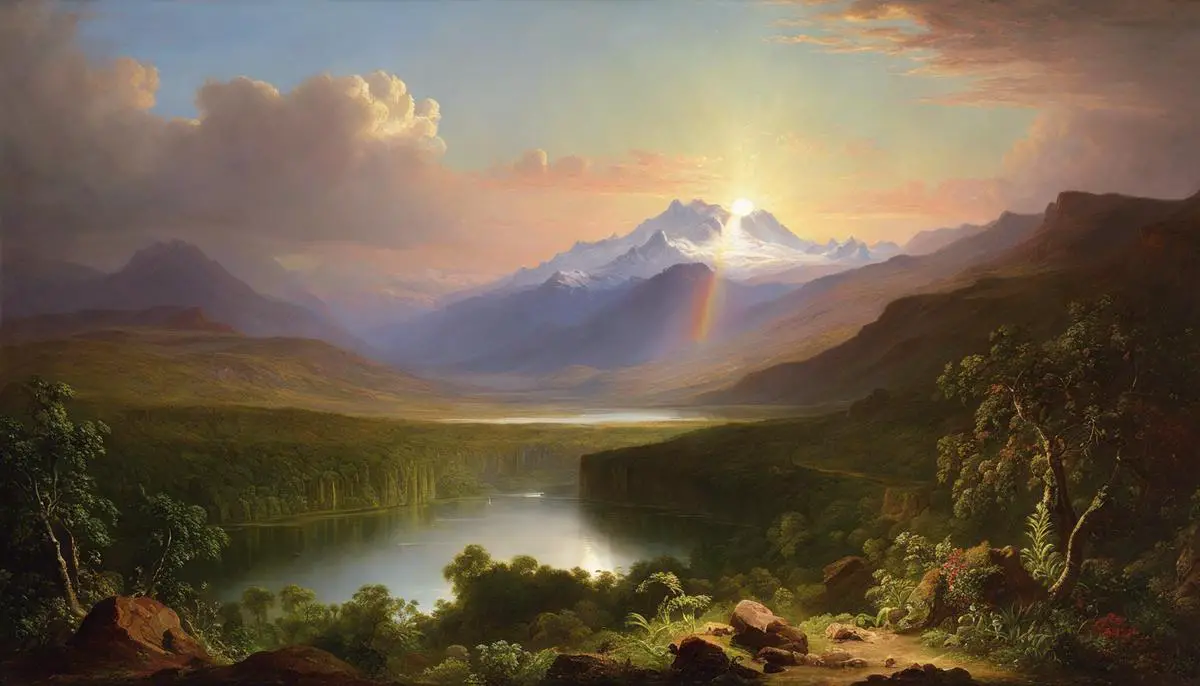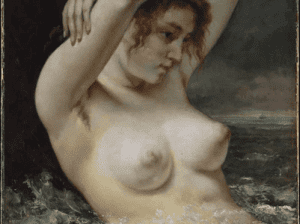Delving into the world of classical art, the Heart of the Andes stands as a colossal testament to the artistic prowess of Frederic Church and the profound influence of the Hudson River School. Within the journey of understanding this masterpiece, one must embark upon an exploration of the artist’s life, the social fabric of his time, the strategic artistic techniques he employed, and the iconic symbols interwoven within the artwork. This comprehensive gaze, weaves a narrative that transports us into Church’s era – a time bustling with diverse socio-political transformations, ultimately embodied in the rich tapestry of his panorama.
Understanding the Context
Title: The Artistic Pulse in Frederic Edwin Church’s “Heart of the Andes”
On the canvas of the 19th-century art scene, Frederic Edwin Church, an American landscape artist, reveals a reflection of wonders – natural and human. One of his most admired works is “Heart of the Andes”, a landscape masterpiece that truly captures the beating heart of art and inspires onlookers with its breathtaking detail and realism. What moved Church to paint this vivid picture? A spectrum of historical and personal circumstances served as the soul-stirring muse.
Frederic Church was part of the Hudson River School – a cadre of visionary artists who used landscape painting as a medium to voice their perspective on natural beauty and its profound relation to human life. Under the mentorship of Thomas Cole, the school’s founder and a proponent of Romantic artistry, Church embarks on an artistic expedition that leans into the exquisite appeal of nature. This romantic, emotional underpinning is a key influence perceivable in “Heart of the Andes”.
The stage for “Heart of the Andes” was set amidst the turbulent mid-19th century, a time when the scientific exploration, political change, and the spiritual quest met at crossroads. While the pursuit of knowledge and advancement led many to explore exotic geographies, the igniting spark for Church came from acclaimed German scientist and explorer, Alexander von Humboldt. Humboldt’s writings about South America, particularly his descriptions of the Andes, stirred Church’s imagination. His heart was captivated by the synergy of science, art, and spirituality that Humboldt showcased in his chronicles.
With each stroke of his brush, Church transported viewers into a mystical realm of the South American landscape. He painted an earthscape that became a refuge for those entwined in the civil unrest back in America — a testament to the power of art as an emotional balm in contentious times.
Yet, the essence of “Heart of the Andes” was not merely ideological. Personal experiences imbued Church’s work with rich emotional hues— namely, the loss of his two young children to diphtheria. This tragedy manifested in the subtly hidden Christian symbolisms in the art piece; a cross stands in a peaceful churchyard, seen through the verdant lushness — possibly, a nod to his children’s passing.
In “Heart of the Andes”, Frederic Edwin Church masterfully conjures a vibrant tapestry of nature, blending his personal life, contemporary exploration, and the essence of 19th-century romantic energy. With layered depth, Church’s work transcends time, providing a window into a moment when art, science, and society danced together on nature’s stage, illustrating the transcendent power inherent in the heart of art itself.

Analysis of the Artistic Style
As we delve deeper into the principles of the Hudson River School and how they shape Church’s masterpiece, “Heart of the Andes,” it’s evident that the artwork is underpinned by key concepts that made this artistic movement remarkable.
Detailed observations of nature demarcate the Hudson River School approach. Church, following the School’s creed, was a master at minutiae. He observed reality keenly, incomplete without the particulars of flora, fauna, and geographical features. He rendered a meticulous transcription of nature in the Heart of the Andes. This realism, transcending to the hyperreal in parts, offers viewers an immersive visual journey, treading vicariously through the rich and varied landscape of the painting, revealing a lush tropical tableau.
Harmony between the human-made and the natural world is another principle of the Hudson River School mirrored in the artwork. In the Heart of the Andes, Church incorporated a humble shrine by the river as a testament to man’s spiritual resilience nestled within nature’s magnificence. This interspersion of architecture melts seamlessly with the wilderness, underpinning the sentiment of man being an intrinsic part of, not apart from, the Great Nature.
The aspiration for transcendence, a core tenet of the Hudson River School philosophy, seeps out from every brushstroke in the Heart of the Andes. Church, in his profound understanding of the sublime in nature and the power of art to convey it, creates a staggeringly beautiful landscape charged with emotional undertones. The transcendental experience isn’t limited merely to the aesthetic appreciation of the piece; it unfolds as a spiritual journey through the majesty of God’s creation.
It’s crucial to understand that among the Hudson River School artists, Church was one of the most committed to the concept of the Sublime. He subscribed to the belief that a well-crafted representation of nature’s grandeur could lead viewers towards divine appreciation and imbue an enlightened contemplation into the nature of their existence.
In conclusion, Church’s Heart of the Andes is a testament to his mastery over the Hudson River School ethos. It is a statement piece that transforms meticulous observation, harmonious representation, and transcendental inspiration into a masterpiece that continues to captivate and inspire observers, just as the majestic Andean landscapes mesmerised Church himself.

Symbolism and Themes
“Embarking on a visual journey through Frederick Church’s “Heart of the Andes”, one can’t help but feel a sense of awe and complexity. The painting harbours deeper meanings beyond its obvious beauty. Creators often weave whispers of their thoughts into their creations and Church is in no way an exception. Keen eyes can discern the landscape brims with symbolism and protective themes expressing humanity’s impact on the natural world.
The sheer scale of this visual feast emphasizes a central theme: our infinitesimal existence set against the grandness of nature. Church provides perspective of nature’s dominant force, reminding us of our ineffably tiny place in the grand scheme. Zombie mountains assert dominance over bygone trees, suggesting Humans aren’t the masters of this universe – nature holds that crown.
Moreover, each of Church’s brush strokes sings an ode to nature’s magnificence. Not merely a snapshot of a physical location, the painting encapsulates the spirit of the South American wilderness. Church painstakingly portrays every cliff, river, tree, and cloudy formation with a level of detail that demands a spectator’s appreciation for nature’s unrivalled masterpiece.
This is compounded by rich sorts of flora and fauna populating the scene, each animal and plant celebrating the thriving ecosystem that exists despite human interference. Each living creature, whether aloft in the sky or rooted firmly on the earth, highlights the sublime energy bubbling within every corner of the natural world, and the importance of preserving it.
The illumination makes a significant commentary on the human-nature relationship. A soft, ethereal light washes over the Andean landscape, Church’s effective use of light and shadow spells warmth and harmony. This pristinely lit foreground contrasts with the tempestuous clouds obscuring the sun, an allegory for humanity’s potential to both preserve and destroy nature.
Coaxing the viewer to dive deeper, Church’s “Heart of the Andes” sheds a spotlight on humanity’s fundamental paradox – our simultaneous reverence for and impact on our environment. Church’s timeless masterpiece is not merely a canvas populated by exquisite attention to detail. It remains a testament to art’s power to highlight environmental stewardship, the bond between mankind and mother nature.
Church masterfully weaves a tapestry of intricate themes into his work, demanding our attention and respect for the close-knit relationship between mankind and the world. The intertwining of manmade elements with natural formations plead for attentiveness to the balance, harmony and necessary respect between human development and preservation of natural wonders.
Sailing into the heart of the Andes, the artwork meticulously leads spectators on a satisfying journey that leaves them with a newfound awareness. It’s a fine example of how art can kindle introspection, a drive to preserve nature’s wonders, and a deep-seated respect for our fragile yet profound connection with the environment. This is the legacy of Frederic Edwin Church’s “Heart of the Andes,” a canvas testimony to the intertwining of life, nature, and humanity’s responsibility to our earth.”

Legacy and Impact
Unveiled in 1859, the “Heart of the Ages” by Frederic Edwin Church had an immeasurable impact on the contemporary art scene. Unlike any other landscape painting of its time, this masterpiece breathed life into the notion of artistry’s power transcending mere aesthetics. The passion and intent are trapped within the canvas, securing its relevance still today.
“Impact” in the art scene of the time is too scant a word; rather, it was a seismic shift that shook the foundations of landscape painting. The Church kept the viewers riveted, fascinated, and desperate for more, transcending conventional landscape norms. As they viewed the “Heart of the Andes,” people were captivated not just by the breathtaking natural beauty, but also by the underlying symbols that sparked intellectual discourse. These two dynamics, the emotional captivation and intellectual engagement, revolutionised the contemporary art sphere.
The painting, with its exotic landscape combined with familiar Christian symbols, created a vision that had the power to transport viewers both physically and emotionally. It paved the way for a new wave of landscape paintings that contained moral or religious messages, interwoven with overtly stunning natural depictions. This transformative capability instilled in art was a harbinger for the art that would follow, giving the artists a new lane to traverse creatively.
Moving forward, the “Heart of the Andes” had a lasting influence on the art world, continuing to inspire artists and audiences. The powerful blend of aesthetic beauty, symbolism, and emotion in Church’s work has shaped the way many artists approach their craft. The way it invites viewers to delve deep beneath the painterly surface and explore the resonating themes has been emulated, but hardly duplicated, in many successive works of art. No wonder, even after more than a century and a half, “Heart of the Andes” remains a significant source of inspiration in the realm of creative artistry.
Looking beyond artistry to culture at large, the “Heart of the Andes” holds an enduring legacy. Its powerful eco-centric themes, highlighting the symbiotic relationship between mankind and nature, has impacted societal thought about environmental preservation. The thriving ecosystem Church captured in his painting has, sadly, become increasingly threatened with the expansion of human development, making Church’s masterpiece a poignant reminder of the need for environmental stewardship. His use of darkness and light to depict mankind’s dual influence and responsibility towards nature has resonated across cultures, reinforcing the urgency of conserving our planet.
In conclusion, the “Heart of the Andes” has engraved itself in the annals of art history, not just for its aesthetic appeal, but for its transformative power in the landscape artistry and beyond. It has left an indelible mark both on artists, as a muse, and on society, as a harbinger of ecological respect. Frederic Edwin Church’s magnum opus continues to captivate, inspire and challenge us, securing its timeless appeal in the artistic world.

Profoundly, Church’s Heart of the Andes is not just an extraordinary artistic creation but a rich ecocritical documentation that permeates across time. Its unique amalgamation of the Hudson River School principles, personal expression, and ecological concern serve to elevate the painting beyond its physical dimensions. The artwork continues to spark conversations on multiple fronts – from the evolution of landscape painting to the pressing discourse on environmental sustainability. It thus signifies the enduring power of art – to provoke thought, inspire action and echo through generations, marking a lasting cultural footprint.
Recommend0 recommendationsPublished in Uncategorized





Responses